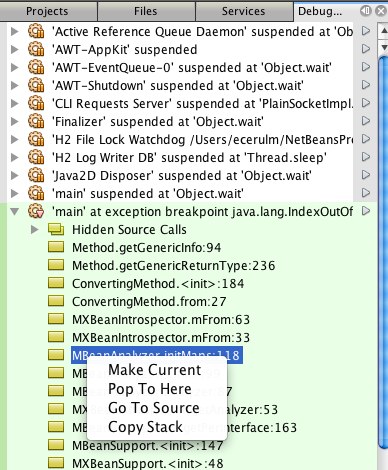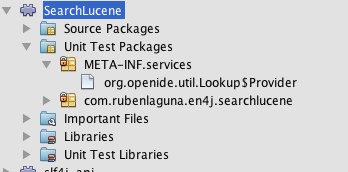I finally decided to release the project I was working on the last year: A java desktop client for the Evernote service.
The distributions for Mac OS X, Linux and Windows can be found on the downloads page.
And the source code can be accesses and forked from the git repository on github.
The README for EN4J-1.0M2
EN4J
What is it?
-----------
EN4J is a client to the Evernote services written in Java. It designed to
become a replacement to the Evernote client for Windows & Mac. Although
currently EN4J is a read-only client and cannot fully replace the
official Evernote client.
Features
--------
* Fast search based on Lucene
* Indexing of word documents, zip files, etc. All doc types supported by Apache Tika
* Based on Netbeans Platform, runs on Windows, Mac OS X and Linux
* Open source
TO DO
-----
* Editable notes
* tags
* Keyring api
* Rich-text clipboard copy
* Ignore diacritical marks during search
Bugs
----
If you find any write a bug report on http://github.com/ecerulm/en4j/issues
How to build and install
------------------------
First, grab the source from github
git clone git://github.com/ecerulm/en4j.git
Then proceed to the main directory
cd en4j/NBPlatformApp
to build the windows zip distribution do
ant build-zip
to build the mac os x distribution do
ant build-mac
Then take the output file in NBPlatformApp/dist
Contribute
----------
Just fork the project from http://github.com/ecerulm/en4j
and send me a pull request with the changes.
Licensing
---------
Please see the file called LICENSE.
Credits
-------
Netbeans team for the Netbeans Plaform and Netbeans IDE
icons: Tango Icon Library http://tango.freedesktop.org/Tango_Icon_Library
icons: Nuvola http://www.icon-king.com/projects/nuvola/
icons: Crystal project http://www.everaldo.com/crystal/
icons: Addictive Flavour. Designed by Mirjami Manninen (http://www.mirkku.com). www.smashingmagazine.com
icons: Bunch of Cool Bluish ICONS http://mebaze.com/
GlazedLists: http://publicobject.com/glazedlists/
Apache Thrift: http://incubator.apache.org/thrift/
TimingFramework: https://timingframework.dev.java.net/
Flying Saucer: https://xhtmlrenderer.dev.java.net/
Apache Tika: http://tika.apache.org/
Apache Commons Collections: http://commons.apache.org/collections/
Apache Commons IO: http://commons.apache.org/io/
Apache Commons Math: http://commons.apache.org/math/
Evernote API: http://www.evernote.com/about/developer/api/
Joda Time library: http://joda-time.sourceforge.net/
NekoHTML: http://nekohtml.sourceforge.net/
renderpack: https://renderpack.dev.java.net/
SLF4J: http://www.slf4j.org
Woodstox: http://woodstox.codehaus.org/
I took me a while to figure out how to rewind the stack while debugging in Netbeans. This feature is called “Drop to Frame” in Eclipse and there is accesible in the toolbar. In Netbeans the feature that allows you to go back in the callstack is called Pop to Here and you invoke it right clicking on the stack. There is also a “Debug / Stack / Pop Topmost Call”

The short answer is that the gray area that you are seeing in lower bottom of the window is actually the editor area (aka document area) and you can hide it by adding
run.args.extra=-J-Dnetbeans.winsys.hideEmptyDocArea=true
to your platform.properties file. Or by calling
System.setProperty("netbeans.winsys.hideEmptyDocArea", "true");
from one of your module’s Installers.
That’s all you need to know but if you are interested on getting some details and references continue reading.
If you create a new Netbeans RCP application and only add TopComponents to modes other than editor (modes which kind=“view”) then you will end up with an empty document area (could be at the bottom, top, left, right or in between TopComponents depending which modes you placed the TCs on). But first, you ask, how do I assign TopComponents to modes? Well you do that in the new Window wizard for example
When I put
run.args.extra=-J-Dnetbeans.winsys.hideEmptyDocArea=true
in my project.properties I got a NullPointerException (NPE) at startup.
I though it was a bug and I reported it but
then I realized that I got the NPE because I had removed/hidden also the editor.wsmode in my layer.xml
...
...
<folder name="Windows2">
<folder name="Modes">
<folder name="editor_hidden"/>
<file name="editor.wsmode_hidden"/>
</folder>
</folder>
...
...
As soon as I removed those entries from the layer.xml hideEmptyDocAre worked perfectly.
If you are experiencing high memory comsumption with Lucene 2.9.0/3.0.1 it could be due…
-
... to a recently reported and fixed bug in StandardTokenizer where JFlex generated code was expanding a buffer (zzBuffer) and never trimming it down
-
... to another recently reported and fixed bug where IndexWriter held references to Readers used in your Fields, (and if you have apache tika's reader, those can take up a lot of space)
I tried to build Apache Tika 0.6 yesterday and I couldn’t build it because the tests failed. The failing tests were
testExcelParserFormatting(org.apache.tika.parser.microsoft.ExcelParserTest)
testExcelFormats(org.apache.tika.parser.microsoft.ooxml.OOXMLParserTest)
and the failure had to to with the fact that the locale was “es_ES” and the numbering format differs ("1.599,99" and not “1,599.99”)
$ mvn -version
Apache Maven 2.2.0 (r788681; 2009-06-26 15:04:01+0200)
Java version: 1.6.0_17
Java home: /System/Library/Frameworks/JavaVM.framework/Versions/1.6.0/Home
Default locale: es_ES, platform encoding: MacRoman
OS name: "mac os x" version: "10.6.2" arch: "x86_64" Family: "mac"@
I changed the locale temporarily to be able to build
If you need to unit test classes in a netbeans module and the classes use the Lookup.getDefault() to “lookup” things that you want to mock you probably wonder how you can place the mock objects in the default Lookup
Adding objects to the Netbeans’s default Lookup is relatively simple. Here is the answer:
-
Replace the `Lookup` instance returned by the `Lookup.getDefault()`
by defining a new entry in `META-INF/services`.

It’s just a matter of adding a file named org.openide.util.Lookup$Provider in the META-INF/services folder inside your Unit Test source folder. That file should contain the fully qualified class name of your own Lookup.Provider implementation.
In my case the file contain just the string com.rubenlaguna.en4j.searchlucene.NoteFinderLuceneImplTest because the test class itself implements Lookup.Provider.
If you want to access the internet via your phone 3G/GPRS connection you can use Bluetooth PAN. In my case I have a Sony Ericsson W715 so the first thing to do is to tell the phone which connection to use Menu > Settings > Connectivity > Bluetooth > Data accounts and select the account that you normally use to browse the net from the phone.
Then turn on bluetooth
Progress indicator (indeterminate mode) which allows to cancel the task
The easiest way of having a cancellable progress indicator (Progress API) for a task in Netbeans Platform Application is the one below but it’s only worth for tasks that don’t update the progress indicator (indeterminate mode) until the task is finished. If you want to update the progress indicator (ProgressHandle) inside the task itself look at the second example.

I’m starting to get tired of OpenJPA/HSQLDB setup that I’ve trying: it seems to give more problems than it solves. Now I discovered that the HSQL db wasn’t been properly shutdown and for reasons that I’m investigating, if the HSQL db is not propertly closed (SHUTDOWN command) it’s impossible to reopen it again. It fails with a IndexOutOfBoundsException.
Caused by: org.hsqldb.HsqlException: error in script file line: 33 java.io.IOException: java.lang.IndexOutOfBoundsException in statement [SET TABLE PUBLIC.NOTES INDEX '2883070']
at org.hsqldb.Error.error(Error.java:111)
at org.hsqldb.scriptio.ScriptReaderText.readDDL(ScriptReaderText.java:132)
at org.hsqldb.scriptio.ScriptReaderBase.readAll(ScriptReaderBase.java:88)
at org.hsqldb.persist.Log.processScript(Log.java:721)
at org.hsqldb.persist.Log.open(Log.java:187)
at org.hsqldb.persist.Logger.openPersistence(Logger.java:209)
at org.hsqldb.Database.reopen(Database.java:265)
at org.hsqldb.Database.open(Database.java:235)
at org.hsqldb.DatabaseManager.getDatabase(DatabaseManager.java:222)
at org.hsqldb.DatabaseManager.newSession(DatabaseManager.java:145)
at org.hsqldb.jdbc.JDBCConnection.<init>(JDBCConnection.java:3219)
... 59 more
Annoying. This is not OpenJPA fault, but it gets complicated to actually solve it.




